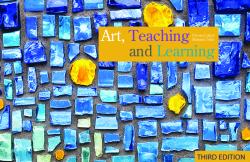Art, Teaching and Learning
Author(s): Teresa Cotner , Masami Toku
Edition: 3
Copyright: 2022
Art, Teaching and Learning provides future teachers of art and other art professionals a breadth and depth of history, context, theory, and practical applications for teaching art in the 21st century. This guide offers a global to regional perspectives on key concepts, terminology and practices with attention to cultural, cognitive, and theoretical diversity and pluralism.
The world needs art and artists. It needs art teachers to educate future artists and an informed public who can appreciate art. But how does one become an art teacher? More importantly, how does one become a great art teacher? Art, Teaching and Learning answers these questions and sets future teachers on a course toward becoming great.
About the Authors
Introduction
Part I. Individual, Local, and Global Perspectives on Art, Teaching and Learning
Introduction
Chapter 1. What Is Art? What Is Art for?
Chapter 2. History of Art Education
Chapter 3. Multimodal Literacies and Aesthetic Development
Part II. Materials and Processes
Introduction
Chapter 4. Two-Dimensional Arts
Chapter 5. Three-Dimensional Arts
Chapter 6. Four-Dimensional Arts
Chapter 7. New Media, Emerging Art, Applied Arts, and Architecture
Part III. Making and Deriving Meaning in Art
Introduction (Including Close Reading of Art and Color Theory)
Chapter 8. The Elements of Art
Chapter 9. The Principles of Design
Chapter 10. Content, Context, and Concept
Part IV. 21st-Century Curriculum Developments
Introduction
Chapter 11. Standards
Chapter 12. Curriculum Design
Appendices
Appendix 1. 21st-Century Research and Trends
Appendix 2. Careers in Art
Bibliography
Art, Teaching and Learning provides future teachers of art and other art professionals a breadth and depth of history, context, theory, and practical applications for teaching art in the 21st century. This guide offers a global to regional perspectives on key concepts, terminology and practices with attention to cultural, cognitive, and theoretical diversity and pluralism.
The world needs art and artists. It needs art teachers to educate future artists and an informed public who can appreciate art. But how does one become an art teacher? More importantly, how does one become a great art teacher? Art, Teaching and Learning answers these questions and sets future teachers on a course toward becoming great.
About the Authors
Introduction
Part I. Individual, Local, and Global Perspectives on Art, Teaching and Learning
Introduction
Chapter 1. What Is Art? What Is Art for?
Chapter 2. History of Art Education
Chapter 3. Multimodal Literacies and Aesthetic Development
Part II. Materials and Processes
Introduction
Chapter 4. Two-Dimensional Arts
Chapter 5. Three-Dimensional Arts
Chapter 6. Four-Dimensional Arts
Chapter 7. New Media, Emerging Art, Applied Arts, and Architecture
Part III. Making and Deriving Meaning in Art
Introduction (Including Close Reading of Art and Color Theory)
Chapter 8. The Elements of Art
Chapter 9. The Principles of Design
Chapter 10. Content, Context, and Concept
Part IV. 21st-Century Curriculum Developments
Introduction
Chapter 11. Standards
Chapter 12. Curriculum Design
Appendices
Appendix 1. 21st-Century Research and Trends
Appendix 2. Careers in Art
Bibliography

